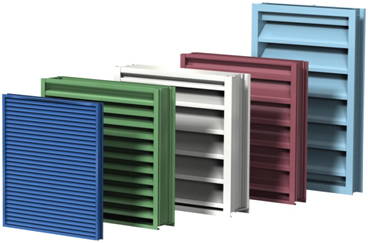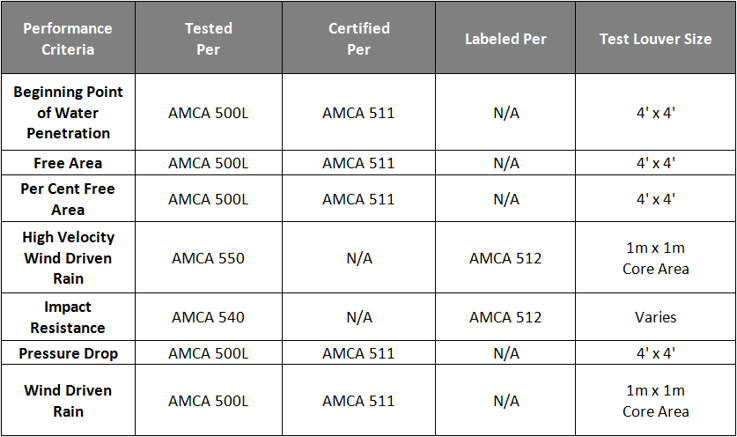Louver Selection Tips From The Pros
 By Gary Macdonald and Randal Geedey, Airolite
By Gary Macdonald and Randal Geedey, Airolite
As an architect or specifer, you are ultimately responsible for establishing the louver requirements for your valued project. When selecting a louver product; performance, familiarity, reputation of a manufacturer, options and cost all play a part. Due to various reasons, architects and specifiers need to be cognizant of numerous variables when selecting a louver product – the depth of a louver, type, blade profile, color, free area, water penetration, pressure drop, AMCA certification and the list continues. Contingent on your application, one or all of these details may come into consideration. For this reason, it is important for architects and specifiers to understand exactly what is being considered and some of the most common pitfalls that can take place when specifying louver products.
The Air Movement and Control Association International (AMCA) Standard 501 defines a louver as: “A device comprising multiple blades, which, when mounted in an opening, permits the flow of air but inhibits the entrance of water or other elements.”
Many different types of louvers are on the market ranging from fixed blades, blades that can open or close, non-drainable or drainable, horizontal or vertical, code driven louvers as well as special application louvers. Each of these louvers is selected for a specific reason. They may be fulfilling a performance criteria, a size and depth requirement for a building condition or substrate, or the louver has the desired aesthetic appearance. The whys and wherefores are seemingly endless, which is why manufacturers offer numerous models and options in several product categories.
LOUVER PERFORMANCE
To certify the performance of a louver, manufacturers are required to submit a physical louver sample to AMCA, the industry’s third-party testing organization. AMCA testing ensures consistency and adherence to common and established standards for testing and product certification, providing architects and specifiers confidence when writing an AMCA licensed product into their specification.
The following table lists the different performance criteria and the standards involved in the testing.
 LOUVER AESTHETICS:
LOUVER AESTHETICS:
As a part of the exterior envelope of a building, the look of the louver can be as important as the performance. Infinite possibilities are only defined by the inspiration of the architect or specifier, as well as the capabilities and guidance of the louver manufacturer.
Below are some examples:
- Applications that require a louver to be built into a shape, such as a circle or triangle.
- Applications that require a large bank of louvers where a portion of the units are active and still require performance considerations, and other areas that are not active and will be blocked or “blanked” off.
- Applications that require louver sections to match those of other trades and building conditions such as the glazing, curtain wall or other aesthetic elements of the project.
- Special color and finish considerations.
There are various types of louver applications, and an even greater amount that haven’t been conceptualized yet. But while aesthetics may be of primary interest, performance should always factor into the selection process, and must not be disregarded.
RECOMMENDATIONS:
When specifying and selecting louver products keep in mind performance, aesthetics and testing certifications. Architects and specifiers will need to consider the performance of a certain blade profile, louver depth and other aesthetic choices in order to get the best performing and best looking product for the project and application. This will help alleviate the issue of creating openings for louvers without knowing if a louver exists that can meet the project and application requirements. Unfortunately, the solution to this situation is rework -- going back to enlarge the original opening which can be very costly if the opening has already been completed. Additionally, using the percent free area to determine the actual free area for your project rather than the free area chart can be disastrous. Remember, the percent free area is based on a 4 ft. x 4 ft. louver and includes the frames in the calculation. For this reason, the percent free area determination is only valid for that particular 4 ft. x 4 ft. louver.
An additional inaccuracy that occurs frequently is specifying either a storm proof or weatherproof louver with the belief there will be a weather resistant shield under all conditions. Simply put, no such louver product is available. All louvers will allow water penetration when subjected to rain driven at a high enough velocity. Hurricanes have been known to force water through precast cement. Under these and other similar scenarios, louvers will ultimately allow weather penetration. Keep in mind that when it comes to wind-driven rain, the louvers are not rated as to whether or not they will allow water penetration, but rather how efficient they are at resisting the weather penetration.
With so many variables to consider in specifying and selecting appropriate louver products, selection criteria based solely on aesthetics or performance may possibly result in selecting a louver product that under performs and fails to meet your client’s expectations. Working with reputable, experienced manufacturers and representatives is a fantastic way to leverage their knowledge and expertise for the best possible product selection for your project. Manufacturers and representatives can typically answer your questions quickly, based upon both technical knowledge and experience, and are a great resource for additional information regarding product applications.
About The Authors:
Gary Macdonald is the product manager for Greenheck and Airolite Architectural Louver products. He is a 25-year veteran in commercial building product sales, specifications and product development. Macdonald holds Bachelor of Science Degrees in Business & Sociology from the University of Wisconsin.
Randal Geedey is the structural engineer for Airolite. Geedey, a 16-year veteran, has been involved in product development and engineering. He has also served on several AMCA committees over the years and currently sits as the chairman of the AMCA Louver Engineering Committee. Geedey has a Bachelor’s Degree in Mechanical Engineering from The Ohio State University.
About Airolite
 For architects,
contractors, and building owners across the US, Airolite provides
innovative product solutions that make a unique visual statement while
performing critical building functions. Airolite architectural louvers,
custom grilles, louver equipment screens, sun controls, and canopies
ventilate, illuminate, reduce glare, prevent water penetration, save
energy, provide visual screens, and add security to new and renovated
buildings—while making a stunning first impression. Airolite calls it “the look
that works.” To learn more, visit www.airolite.com.
For architects,
contractors, and building owners across the US, Airolite provides
innovative product solutions that make a unique visual statement while
performing critical building functions. Airolite architectural louvers,
custom grilles, louver equipment screens, sun controls, and canopies
ventilate, illuminate, reduce glare, prevent water penetration, save
energy, provide visual screens, and add security to new and renovated
buildings—while making a stunning first impression. Airolite calls it “the look
that works.” To learn more, visit www.airolite.com.

